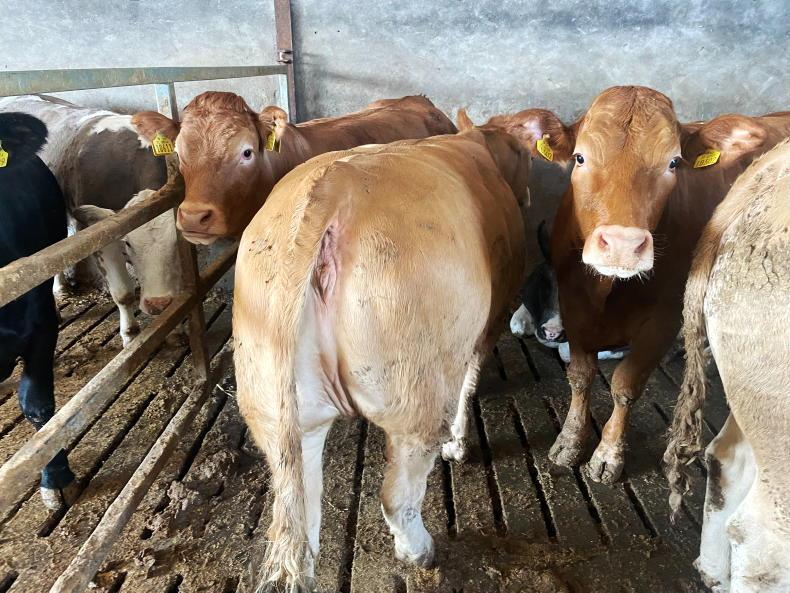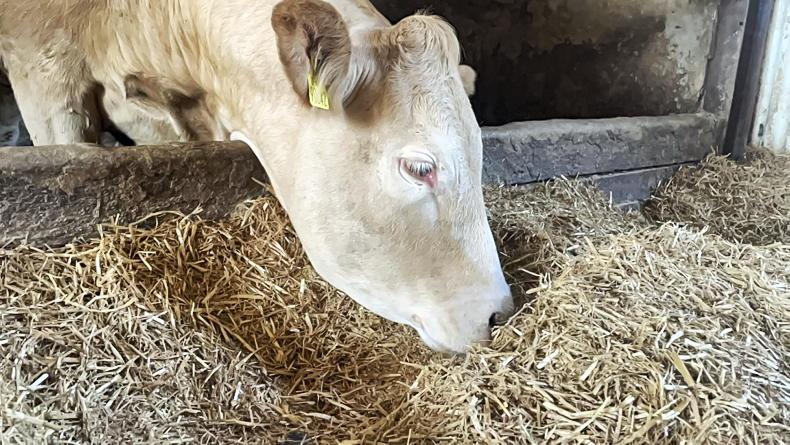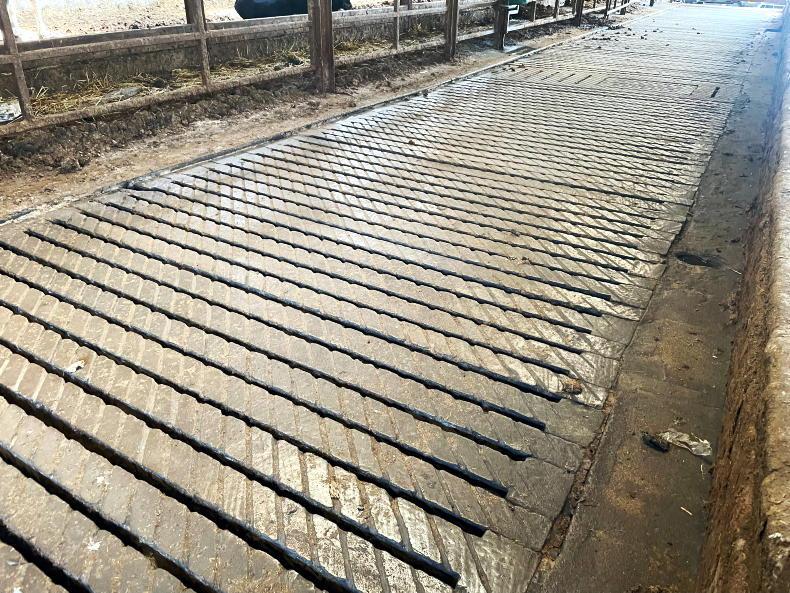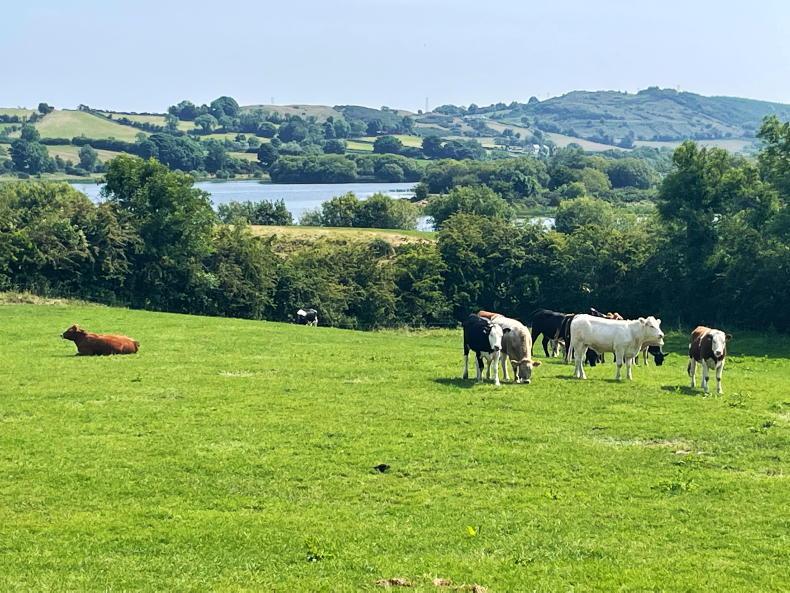The farm
Location: Shercock, Co Cavan.Farming system: Store to finishing. Farm size: 115 acres.Animal numbers: 600-700 finished annually.Breeds: Continental and traditional breeds.
Space for nature: 16%.Carbon footprint: 7.7kg CO2/kg.Cavan is famous for humps and hollows, and legend has it that there are 365 lakes in Co Cavan – one for every day of the year. Farming in Drumlin country, with lots of water around you, isn’t simple and you need to be on your game when it comes to adhering to buffer zones for maintaining water quality.
One man on top of his game is Samuel Hill. Sam farms 65 acres of grassland and 50 acres of tillage in east Cavan. The Hill family runs a beef finishing operation, finishing 600-700 cattle annually.
“I’m buying in marts every week to be able to deliver roughly 17 cattle a week to the factory. We generally have about 230 cattle in the yard at any one time and we leave the sheds empty for July and August every year,” Sam said.
Cattle are purchased in local marts all year round and finished for 70-90 days, on an intensive diet. Sam places a big emphasis on his processor relationship and sticks with the same processor all year.

Sam Hill.

“I know what they want and if I provide them with exactly what they want on a regular basis, that means I’m in a better position to negotiate on price. If you have the name delivering exactly what’s required on a consistent, regular basis, it works for everybody. I know where I stand and they know where they stand.”
Sam, along with his brother-in-law, buy most of the cattle. They are sourced at local marts, like Kingscourt, Ballybay, Cootehill and Ballyjamesduff. Cattle are back on a bed of straw after they are purchased, and are fed hay for about a week just to settle them in. They are kept away from other cattle for seven days, and during this time they get a dose for fluke and worms, and are vaccinated for IBR. Once the acclimatisation period is over, cattle are housed in slatted pens.

Cattle are fed hay for about a week just to settle them in.
Feed
The 50 acres of tillage provides Sam with 130-140t of barley annually. Straw is also used for feeding and bedding. A further 300t of straights are purchased every year on the farm. Everything is fed as a total mixed ration via a diet feeder.
The diet generally consists of barley, soya hulls and maize meal, along with good-quality silage and straw for roughage. All cattle are finished as bullocks and heifers with Sam moving away from bulls a few years ago.
“The factory didn’t really want bulls any more so I moved away from them. We are aiming for 1.6kg/day on the continental cattle and 1.3-1.4kg/day with the traditional breeds. We are feeding the traditional cattle about 70 days and the continentals go out after about 90 days.”

Cattle are housed in slatted pens.
Milltown Farm Meats
A few years ago the Hill family set up Milltown Family Meats. The Hills slaughter one of there own animals on a regular basis and sell the meat online, and also at local farmers’ markets.
Sam is firmly focused on farming with the environment and pays close attention to buffer zones and spreading dates.
All slurry is spread via a dribble bar and the farm is soil tested every three to four years to determine fertility status.
Water quality in the area is good, with the lake adjacent to Sam’s home farm being used to supply the local town with drinking water.
Speaking on behalf of one of the competition sponsors, Meat Industry Ireland, Dale Crammond said: “As outlined in the Irish Beef Sector Sustainability Report and Roadmap to 2030, early finishing of cattle could reduce emissions by up to 820,000t a year by 2030.
“Significant progress has been made to date to achieve a current average of 26 months. This has been achieved as part of a suite of connected market specifications, driven by bonuses that rewarded farmers for the additional efforts undertaken to supply our international customers with beef products that meet the demands of consumers. The recently published revised Teagasc Marginal Abatement Cost Curve also underlines the importance of earlier finishing.”

The farm
Location: Shercock, Co Cavan.Farming system: Store to finishing. Farm size: 115 acres.Animal numbers: 600-700 finished annually.Breeds: Continental and traditional breeds. Space for nature: 16%.Carbon footprint: 7.7kg CO2/kg.Cavan is famous for humps and hollows, and legend has it that there are 365 lakes in Co Cavan – one for every day of the year. Farming in Drumlin country, with lots of water around you, isn’t simple and you need to be on your game when it comes to adhering to buffer zones for maintaining water quality.
One man on top of his game is Samuel Hill. Sam farms 65 acres of grassland and 50 acres of tillage in east Cavan. The Hill family runs a beef finishing operation, finishing 600-700 cattle annually.
“I’m buying in marts every week to be able to deliver roughly 17 cattle a week to the factory. We generally have about 230 cattle in the yard at any one time and we leave the sheds empty for July and August every year,” Sam said.
Cattle are purchased in local marts all year round and finished for 70-90 days, on an intensive diet. Sam places a big emphasis on his processor relationship and sticks with the same processor all year.

Sam Hill.

“I know what they want and if I provide them with exactly what they want on a regular basis, that means I’m in a better position to negotiate on price. If you have the name delivering exactly what’s required on a consistent, regular basis, it works for everybody. I know where I stand and they know where they stand.”
Sam, along with his brother-in-law, buy most of the cattle. They are sourced at local marts, like Kingscourt, Ballybay, Cootehill and Ballyjamesduff. Cattle are back on a bed of straw after they are purchased, and are fed hay for about a week just to settle them in. They are kept away from other cattle for seven days, and during this time they get a dose for fluke and worms, and are vaccinated for IBR. Once the acclimatisation period is over, cattle are housed in slatted pens.

Cattle are fed hay for about a week just to settle them in.
Feed
The 50 acres of tillage provides Sam with 130-140t of barley annually. Straw is also used for feeding and bedding. A further 300t of straights are purchased every year on the farm. Everything is fed as a total mixed ration via a diet feeder.
The diet generally consists of barley, soya hulls and maize meal, along with good-quality silage and straw for roughage. All cattle are finished as bullocks and heifers with Sam moving away from bulls a few years ago.
“The factory didn’t really want bulls any more so I moved away from them. We are aiming for 1.6kg/day on the continental cattle and 1.3-1.4kg/day with the traditional breeds. We are feeding the traditional cattle about 70 days and the continentals go out after about 90 days.”

Cattle are housed in slatted pens.
Milltown Farm Meats
A few years ago the Hill family set up Milltown Family Meats. The Hills slaughter one of there own animals on a regular basis and sell the meat online, and also at local farmers’ markets.
Sam is firmly focused on farming with the environment and pays close attention to buffer zones and spreading dates.
All slurry is spread via a dribble bar and the farm is soil tested every three to four years to determine fertility status.
Water quality in the area is good, with the lake adjacent to Sam’s home farm being used to supply the local town with drinking water.
Speaking on behalf of one of the competition sponsors, Meat Industry Ireland, Dale Crammond said: “As outlined in the Irish Beef Sector Sustainability Report and Roadmap to 2030, early finishing of cattle could reduce emissions by up to 820,000t a year by 2030.
“Significant progress has been made to date to achieve a current average of 26 months. This has been achieved as part of a suite of connected market specifications, driven by bonuses that rewarded farmers for the additional efforts undertaken to supply our international customers with beef products that meet the demands of consumers. The recently published revised Teagasc Marginal Abatement Cost Curve also underlines the importance of earlier finishing.”












 This is a subscriber-only article
This is a subscriber-only article










SHARING OPTIONS: